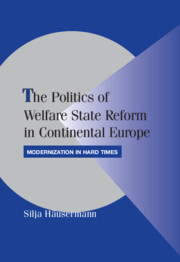Book contents
- Frontmatter
- Contents
- List of Figures
- List of Tables
- Preface
- The Politics of Welfare State Reform in Continental Europe
- 1 “EPPUR SI MUOVE”: WELFARE STATE CHANGE DESPITE INSTITUTIONAL INERTIA
- 2 MODERNIZATION IN HARD TIMES: THE POST-INDUSTRIAL POLITICS OF CONTINENTAL WELFARE STATE REFORM
- Part I Pension Reform in Continental Europe: A Framework of Analysis
- Part II Determinants of Successful Pension Reform in Continental Europe
- 6 FRANCE: TRADE UNION FRAGMENTATION AS AN OPPORTUNITY FOR REFORM
- 7 GERMANY: INSTITUTIONAL OBSTACLES TO MULTIDIMENSIONAL REFORM POLITICS
- 8 SWITZERLAND: RECALIBRATION AS AN ENABLING MECHANISM OF PENSION COMPROMISES
- 9 CONCLUSION: REFORM OUTPUTS AND POLITICAL IMPLICATIONS
- Appendices
- References
- Index
- Cambridge Studies in Comparative Politics
8 - SWITZERLAND: RECALIBRATION AS AN ENABLING MECHANISM OF PENSION COMPROMISES
Published online by Cambridge University Press: 06 July 2010
- Frontmatter
- Contents
- List of Figures
- List of Tables
- Preface
- The Politics of Welfare State Reform in Continental Europe
- 1 “EPPUR SI MUOVE”: WELFARE STATE CHANGE DESPITE INSTITUTIONAL INERTIA
- 2 MODERNIZATION IN HARD TIMES: THE POST-INDUSTRIAL POLITICS OF CONTINENTAL WELFARE STATE REFORM
- Part I Pension Reform in Continental Europe: A Framework of Analysis
- Part II Determinants of Successful Pension Reform in Continental Europe
- 6 FRANCE: TRADE UNION FRAGMENTATION AS AN OPPORTUNITY FOR REFORM
- 7 GERMANY: INSTITUTIONAL OBSTACLES TO MULTIDIMENSIONAL REFORM POLITICS
- 8 SWITZERLAND: RECALIBRATION AS AN ENABLING MECHANISM OF PENSION COMPROMISES
- 9 CONCLUSION: REFORM OUTPUTS AND POLITICAL IMPLICATIONS
- Appendices
- References
- Index
- Cambridge Studies in Comparative Politics
Summary
This chapter shows that targeting and recalibration, in addition to cost containment, became important conflict lines in Swiss pension policy making from the 1980s onward. In addition, the empirical analysis demonstrates how targeting and recalibration have given rise to considerable intra-class heterogeneity and even to the formation of social-liberal value alliances – a coalitional pattern that differs sharply from the increasing class polarization that can be observed with regard to cost containment. Finally, this chapter shows that the Swiss institutional framework – characterized by multiple veto points, power fragmentation, and therefore strong requirements for consensus – was highly important for Swiss pension politics from the creation of these schemes all the way to the present: before the 1970s, these institutions impeded the rapid growth of pension expenditures. But more recently, they enabled reforms by facilitating coalitional flexibility and coalitional engineering. Hence, modernizing compromises (Bonoli 2005; Levy 1999) became a necessary condition for successful reforms.
Let me start the analysis of post-industrial Swiss pension politics with a brief account of the reform trajectory since the early 1970s. The concept of a multitiered (as opposed to universal) pension scheme was adopted in a constitutional amendment in 1971, after several years of intense political conflict. The far left and the trade unions had wanted to strengthen the first pay-as-you-go (PAYG) tier, whereas the right favored an expansion of coverage through occupational pensions.
- Type
- Chapter
- Information
- The Politics of Welfare State Reform in Continental EuropeModernization in Hard Times, pp. 166 - 195Publisher: Cambridge University PressPrint publication year: 2010

